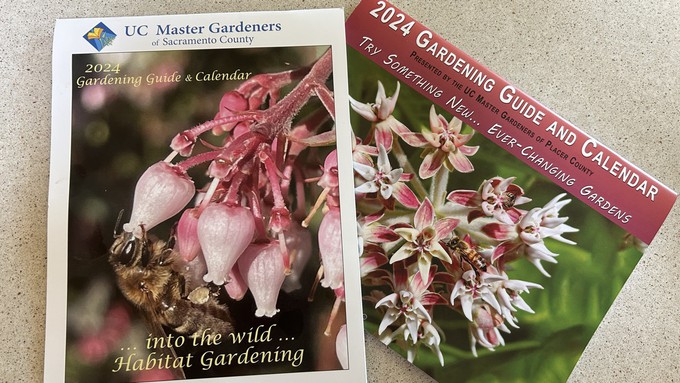
Sacramento, Placer master gardeners stuff these guides with useful information

Great minds think alike! The two gardening guides both have 2024 covers with bees and native flowering plants. But the content is different -- and tailored for each growing area. Kathy Morrison
We have just one month until the 2024 gardening season begins. And there's even less time to shop for holiday gifts for gardener friends and relatives.
Here's my best suggestion to cover both situations: Get yourself -- and those gardening gift recipients -- a 2024 Gardening Guide and Calendar. Both the Sacramento and Placer counties' master gardener groups produce stunning and incredibly useful versions, tailored to the gardens in our region. (Full disclosure: I'm one of the contributing writers to the Sacramento version.)
The price is right, just $12 each including sales tax, and available online or at area nurseries/retail outlets. Sacramento's can be ordered here; the retail sellers are listed on the same page. Placer's order page is here, which also includes a link to the retailers carrying it in Placer, Nevada and El Dorado counties.
Prices for calendars purchased at retailers may be slightly higher; online orders include postage costs.
Both gardening guides are fundraisers to support these busy master gardener programs, which rely tremendously on volunteers and donations.
If you want to order online, I would hurry and do it before Dec. 8. I've heard though the grapevine that UC Agriculture and Natural Resources -- the UC Cooperative Extension's umbrella department -- will be moving its servers to a new data center Dec. 8-10, so the websites will be down for that period.
So what's in these calendars? The Sacramento guide for 2024 focuses on "Habitat Gardening, " with calendar pages devoted to plants that benefit wildlife. January, for example, focuses on native oaks, a "keystone species" for California birds, butterflies and other insects. Behind the calendar pages is essentially a mini course on habitat gardening, discussing plant families, beneficials, local habitats to visit and bird-friendly practices. The Sacramento month-by-month planting chart is a standard part of the annual guide.
The Placer master gardeners in their Valley- and foothills-tailored guide suggest "Try Something New." February's article, for example, looks at "Redefining Your Garden," perfect for the time of year when planning rather than planting is a gardener's primary activity. April's page discusses "Succulents in Small Spaces," certainly a great topic for folks with limited growing space.
Both guides are like having a master gardener in your back pocket, plus an at-your-fingertips place to record weather notes, monthly reminders and quarterly garden duties. (Sprayed your peach trees yet?) I really couldn't garden without mine!
Comments
0 comments have been posted.Sacramento Digs Gardening to your inbox.
Food in My Back Yard Series
May 6: Maintain soil moisture with mulch for garden success
April 29: What's (already) wrong with my tomato plants?
April 22: Should you stock up on fertilizer? (Yes!)
April 15: Grow culinary herbs in containers
April 8: When to plant summer vegetables
April 1: Don't be fooled by these garden myths
March 25: Fertilizer tips: How to 'feed' your vegetables for healthy growth
March 18: Time to give vegetable seedlings some more space
March 11: Ways to win the fight against weeds
March 4: Potatoes from the garden
Feb. 25: Plant a fruit tree now -- for later
Feb. 18: How to squeeze more food into less space
Feb. 11: When to plant? Consider staggering your transplants
Feb. 4: Starting in seed starting
Sites We Like
Garden Checklist for week of May 4
Enjoy this spring weather – and get gardening!
* Plant, plant, plant! It’s prime planting season in the Sacramento area. Time to set out those tomato transplants along with peppers and eggplants. Pinch off any flowers on new transplants to make them concentrate on establishing roots instead of setting premature fruit.
* Direct-seed melons, cucumbers, summer squash, corn, radishes, pumpkins and annual herbs such as basil.
* Harvest cabbage, lettuce, peas and green onions.
* In the flower garden, direct-seed sunflowers, cosmos, salvia, zinnias, marigolds, celosia and asters. (You also can transplant seedlings for many of the same flowers.)
* Plant dahlia tubers. Other perennials to set out include verbena, coreopsis, coneflower and astilbe.
* Transplant petunias, marigolds and perennial flowers such as astilbe, columbine, coneflowers, coreopsis, dahlias, rudbeckia and verbena.
* Keep an eye out for slugs, snails, earwigs and aphids that want to dine on tender new growth.
* Feed summer bloomers with a balanced fertilizer.
* For continued bloom, cut off spent flowers on roses as well as other flowering plants.
* Add mulch to the garden to maintain moisture. Mulch also cuts down on weeds. But don’t let it mound around the stems or trunks of trees or shrubs. Leave about a 6-inch to 1-foot circle to avoid crown rot or other problems.